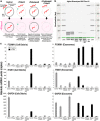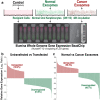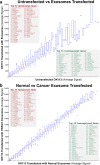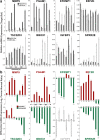Transcriptome reprogramming by cancer exosomes: identification of novel molecular targets in matrix and immune modulation
- PMID: 30008265
- PMCID: PMC6047127
- DOI: 10.1186/s12943-018-0846-5
Transcriptome reprogramming by cancer exosomes: identification of novel molecular targets in matrix and immune modulation
Abstract
Background: Exosomes are extracellular vesicles released by almost all cell types, including cancer cells, into bodily fluids such as saliva, plasma, breast milk, semen, urine, cerebrospinal fluid, amniotic fluid, synovial fluid and sputum. Their key function being intercellular communication with both neighbouring as well as distant cells. Cancer exosomes have been shown to regulate organ-specific metastasis. However, little is known about the functional differences and molecular consequences of normal cells responding to exosomes derived from normal cells compared to those derived from cancer cells.
Methods: Here, we characterised and compared the transcriptome profiles of primary human normal oral keratinocytes (HNOK) in response to exosomes isolated from either primary HNOK or head and neck squamous cell carcinoma (HNSCC) cell lines.
Results: In recipient HNOK cells, we found that regardless of normal or cancer derived, exosomes altered molecular programmes involved in matrix modulation (MMP9), cytoskeletal remodelling (TUBB6, FEZ1, CCT6A), viral/dsRNA-induced interferon (OAS1, IFI6), anti-inflammatory (TSC22D3), deubiquitin (OTUD1), lipid metabolism and membrane trafficking (BBOX1, LRP11, RAB6A). Interestingly, cancer exosomes, but not normal exosomes, modulated expression of matrix remodelling (EFEMP1, DDK3, SPARC), cell cycle (EEF2K), membrane remodelling (LAMP2, SRPX), differentiation (SPRR2E), apoptosis (CTSC), transcription/translation (KLF6, PUS7). We have also identified CEP55 as a potential cancer exosomal marker.
Conclusions: In conclusion, both normal and cancer exosomes modulated unique gene expression pathways in normal recipient cells. Cancer cells may exploit exosomes to confer transcriptome reprogramming that leads to cancer-associated pathologies such as angiogenesis, immune evasion/modulation, cell fate alteration and metastasis. Molecular pathways and biomarkers identified in this study may be clinically exploitable for developing novel liquid-biopsy based diagnostics and immunotherapies.
Keywords: Biomarkers; CEP55; ESCRT, exosomes; Extracellular vesicles; FOXM1; Reprogramming.
Conflict of interest statement
Ethics approval and consent to participate
Not applicable.
Consent for publication
Not applicable.
Competing interests
The authors declare that they have no competing interests.
Publisher’s Note
Springer Nature remains neutral with regard to jurisdictional claims in published maps and institutional affiliations.
Figures







Similar articles
-
Downstream targets of FOXM1: CEP55 and HELLS are cancer progression markers of head and neck squamous cell carcinoma.Oral Oncol. 2010 Jul;46(7):536-42. doi: 10.1016/j.oraloncology.2010.03.022. Epub 2010 Apr 18. Oral Oncol. 2010. PMID: 20400365
-
miR-365 (microRNA): Potential Biomarker in Oral Squamous Cell Carcinoma Exosomes and Extracellular Vesicles.Int J Mol Sci. 2020 Jul 27;21(15):5317. doi: 10.3390/ijms21155317. Int J Mol Sci. 2020. PMID: 32727045 Free PMC article.
-
Elevated exosomal lysyl oxidase like 2 is a potential biomarker for head and neck squamous cell carcinoma.Laryngoscope. 2020 May;130(5):E327-E334. doi: 10.1002/lary.28142. Epub 2019 Jun 20. Laryngoscope. 2020. PMID: 31219623
-
Exosomes in head and neck cancer: Roles, mechanisms and applications.Cancer Lett. 2020 Dec 1;494:7-16. doi: 10.1016/j.canlet.2020.07.005. Epub 2020 Aug 8. Cancer Lett. 2020. PMID: 32781015 Review.
-
The roles of extracellular vesicles in the development, microenvironment, anticancer drug resistance, and therapy of head and neck squamous cell carcinoma.J Exp Clin Cancer Res. 2021 Jan 21;40(1):35. doi: 10.1186/s13046-021-01840-x. J Exp Clin Cancer Res. 2021. PMID: 33478586 Free PMC article. Review.
Cited by
-
Exosomes: Mediators of cellular communication in potentially malignant oral lesions and head and neck cancers.F1000Res. 2023 Oct 4;12:58. doi: 10.12688/f1000research.127368.2. eCollection 2023. F1000Res. 2023. PMID: 38059133 Free PMC article. Review.
-
Beyond liquid biopsy: Toward non-invasive assays for distanced cancer diagnostics in pandemics.Biosens Bioelectron. 2022 Jan 15;196:113698. doi: 10.1016/j.bios.2021.113698. Epub 2021 Oct 12. Biosens Bioelectron. 2022. PMID: 34688113 Free PMC article. Review.
-
Extracellular vesicles in oral squamous cell carcinoma: current progress and future prospect.Front Bioeng Biotechnol. 2023 May 26;11:1149662. doi: 10.3389/fbioe.2023.1149662. eCollection 2023. Front Bioeng Biotechnol. 2023. PMID: 37304135 Free PMC article. Review.
-
Unravelling the proteomic signature of extracellular vesicles released by drug-resistant Leishmania infantum parasites.PLoS Negl Trop Dis. 2020 Jul 6;14(7):e0008439. doi: 10.1371/journal.pntd.0008439. eCollection 2020 Jul. PLoS Negl Trop Dis. 2020. PMID: 32628683 Free PMC article.
-
Assessment of extracellular vesicle isolation methods from human stool supernatant.J Extracell Vesicles. 2022 Apr;11(4):e12208. doi: 10.1002/jev2.12208. J Extracell Vesicles. 2022. PMID: 35383410 Free PMC article.
References
Publication types
MeSH terms
Substances
LinkOut - more resources
Full Text Sources
Other Literature Sources
Medical
Molecular Biology Databases
Miscellaneous

